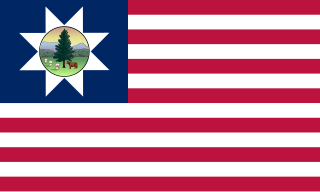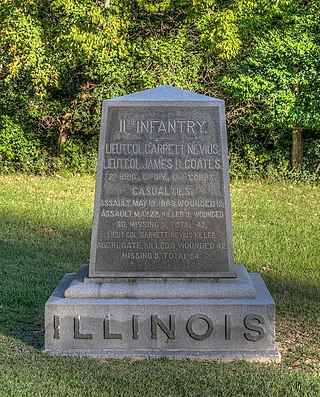2nd New Hampshire Infantry Regiment was the longest-serving volunteer regiment of the State of New Hampshire in the American Civil War.

The 3rd Vermont Infantry Regiment was a three-years infantry regiment in the Union Army during the American Civil War. It served in the eastern theater, predominantly in the VI Corps, Army of the Potomac, from July 1861 to July 1865. It was a member of the Vermont Brigade.

The 2nd Vermont Infantry Regiment was a three years' infantry regiment in the Union Army during the American Civil War. It served in the eastern theater, predominantly in the VI Corps, Army of the Potomac, from June 1861 to July 1865. It was a member of the famous Vermont Brigade.

The 6th Vermont Infantry Regiment was a three years' infantry regiment in the Union Army during the American Civil War. Organized at Montpelier and mustered in October 15, it served in the Army of the Potomac (AoP). It departed Vermont for Washington, DC, October 19, 1861. It served in the Eastern Theater, predominantly in the VI Corps, AoP, from October 1861 to June 1865. It was a part of the Vermont Brigade.

The 6th Wisconsin Infantry Regiment was an infantry regiment that served in the Union Army during the American Civil War. It spent most of the war as a part of the famous Iron Brigade in the Army of the Potomac.

The 9th Illinois Infantry Regiment was an infantry regiment that served in the Union Army during the American Civil War.

32nd Regiment Indiana Volunteer Infantry was a Union Army infantry regiment during the American Civil War. It was also known as Indiana's "1st German" regiment because its members were mainly of German descent. Organized at Indianapolis, the regiment's first recruits mustered into service on August 24, 1861. From 1861 to 1865, the 32nd Indiana was attached to the first Army of the Ohio and the Army of the Cumberland, where it served in the Western Theater.

The 125th New York Infantry Regiment was a volunteer regiment from Rensselaer County, New York, during the American Civil War. Formed during the summer of 1862, the unit was officially mustered into United States Service on 27–29 August 1862, by Col. George L. Willard. He had seen previous service in the Mexican War as well. Levin Crandall was commissioned lieutenant colonel, and James C. Bush major. The unit was mustered out on 5 June 1865.
The 17th New York Veteran Infantry Regiment was an infantry regiment that served in the United States Army during the American Civil War. It was often referred to as the 17th New York Veteran Zouaves and has been erroneously reported as using mules as mounts during Sherman's March to the Sea up until the Grand Review of the Armies. The regiment wore the Hawkins Zouave pattern uniform, which was first used by the 9th New York Volunteer Infantry, Hawkins Zouaves, and later was adopted by several other regiments including the 164th New York, 35th New Jersey and others.

The 125th Illinois Volunteer Infantry was an infantry regiment from Illinois that served in the Union Army during the American Civil War. Soon after mustering into Federal service in September 1862, the regiment fought at Perryville. After being stationed at Nashville, Tennessee, the unit briefly fought at Chickamauga and served in the Chattanooga and Knoxville campaigns in 1863. The regiment participated in the Atlanta campaign in 1864, where it took heavy losses at Kennesaw Mountain. It also fought at Peachtree Creek and Jonesborough. At the end of 1864, it served during Sherman's March to the Sea and in 1865 the unit fought in the Carolinas campaign. The regiment participated in the Grand Review of the Armies before being mustered out of service in June 1865.
The 9th Maine Infantry Regiment was an infantry regiment that served in the Union Army during the American Civil War.
The 4th New Hampshire Infantry Regiment was an infantry regiment that served in the Union Army during the American Civil War.
The 9th New Hampshire Infantry Regiment was an infantry regiment that served in the Union Army during the American Civil War.
The 12th New Hampshire Infantry Regiment was an infantry regiment that served in the Union Army during the American Civil War. It was also a unit that existed for a time following the Revolutionary War.
The 15th New Hampshire Infantry Regiment was an infantry regiment that served in the Union Army during the American Civil War.
The 18th New Hampshire Infantry Regiment was an infantry regiment that served in the Union Army during the American Civil War.
The 27th Massachusetts Volunteer Infantry was an infantry regiment recruited in Massachusetts for service in the American Civil War.

The 11th Regiment Illinois Volunteer Infantry was an infantry regiment from Illinois that served in the Union Army during the American Civil War. In April 1861, it was formed as a three-month volunteer unit, and in July 1861 it was reorganized as a three-year unit, in which role it served until the end of the war. Two of its commanding officers were promoted to brigadier general and led major units during the war. In its first major action at Fort Donelson the regiment suffered terrible losses. The 11th Illinois also fought at Shiloh, Riggins Hill, Vicksburg, First Yazoo City, Second Yazoo City, and Fort Blakely. In April 1863, the 109th Illinois Infantry Regiment was disbanded and its enlisted men transferred into the 11th Illinois. The regiment was mustered out of service in July 1865.

The 103rd Illinois Volunteer Infantry Regiment was an infantry regiment that served for three years during the American Civil War. Organized in Peoria, Illinois, and formed from men entirely within Fulton County, Illinois, the group left Illinois, serving with Sherman through the Atlanta Campaign, March to the Sea and Carolina Campaign. Finally, the regiment participated in the troop review in Washington, D.C., before mustering out in Chicago, and traveling back to their homes.
The 3rd Missouri Infantry Regiment served in the Confederate States Army during the American Civil War. The infantry regiment was officially mustered into service on January 17, 1862. It fought at the Battle of Pea Ridge in Arkansas in March before being transferred across the Mississippi River. While stationed at Corinth, Mississippi, the regiment played a minor role in the Battle of Farmington before the evacuation of the town. In September, the unit saw light action at the Battle of Iuka before being heavily engaged during the Second Battle of Corinth as the Confederates attempted to retake the town in October. In early 1863, the regiment was transferred to Grand Gulf, Mississippi, in order to strengthen the defenses of the Mississippi River at that point. At the Battle of Grand Gulf on April 29, the unit helped repulse a Union Navy attack against the Confederate defensive works. After elements of the Union Army of the Tennessee landed below Grand Gulf, the regiment fought in a delaying action at the Battle of Port Gibson on May 1.






